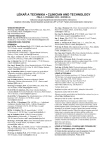Effect of linear accelerator settings on evaluation of dosimetric verification of VMAT plans
Background and purpose:
Comparison of the measured and the calculated 2D dose distributions in the planning system is one of the standard methods of VMAT (volumetric-modulated arc therapy) plans verification in radiotherapy. The aim of this paper is to assess the ability of the QA (quality assurance) method used at the University Hospital Olomouc to detect significant errors in the linear accelerator settings and to estimate clinical impact of the undetected changes.
Materials and methods:
To study this issue we chose a method based on introducing simulated errors in gantry and MLC (multi-leaf collimator) settings into 10 clinical VMAT plans of the prostate and the head and neck patients. The ability of the verification system to recognize changes in prescribed setting is - for the purpose of this paper - characterized by a maximum error, in which the two dose distributions are evaluated as sufficiently identical within the parameters of gamma analysis. VMAT plans with the maximum undetected error were recalculated back into the real patient anatomy in order to assess the potential clinical impact.
Results:
The verification method including 3%/3mm gamma analysis criteria together with Octavius II system is able to detect errors larger than 2mm in MLC and 3° in gantry settings in the head and neck VMAT plans and 3mm and 5° for prostate VMATs. In comparison with the original plan, dose recalculations with these errors in the settings back into the real patients showed differences in dose distributions.
Conclusion:
Comparison of dose volume histograms for the original plan and the plans recalculated with implemented errors indicate that this system of verification of VMAT plans could cover up clinically relevant errors.
Keywords:
Volumetric modulated arc therapy (VMAT), Octavius QA system, gamma analysis
Autoři:
Václav Novák; Ivo Přidal; David Gremlica
Působiště autorů:
Czech Republic
; Department of Medical Physics and Radiation Protection, University Hospital Olomouc
Vyšlo v časopise:
Lékař a technika - Clinician and Technology No. 4, 2015, 45, 110-114
Kategorie:
Původní práce
Souhrn
Background and purpose:
Comparison of the measured and the calculated 2D dose distributions in the planning system is one of the standard methods of VMAT (volumetric-modulated arc therapy) plans verification in radiotherapy. The aim of this paper is to assess the ability of the QA (quality assurance) method used at the University Hospital Olomouc to detect significant errors in the linear accelerator settings and to estimate clinical impact of the undetected changes.
Materials and methods:
To study this issue we chose a method based on introducing simulated errors in gantry and MLC (multi-leaf collimator) settings into 10 clinical VMAT plans of the prostate and the head and neck patients. The ability of the verification system to recognize changes in prescribed setting is - for the purpose of this paper - characterized by a maximum error, in which the two dose distributions are evaluated as sufficiently identical within the parameters of gamma analysis. VMAT plans with the maximum undetected error were recalculated back into the real patient anatomy in order to assess the potential clinical impact.
Results:
The verification method including 3%/3mm gamma analysis criteria together with Octavius II system is able to detect errors larger than 2mm in MLC and 3° in gantry settings in the head and neck VMAT plans and 3mm and 5° for prostate VMATs. In comparison with the original plan, dose recalculations with these errors in the settings back into the real patients showed differences in dose distributions.
Conclusion:
Comparison of dose volume histograms for the original plan and the plans recalculated with implemented errors indicate that this system of verification of VMAT plans could cover up clinically relevant errors.
Keywords:
Volumetric modulated arc therapy (VMAT), Octavius QA system, gamma analysis
Zdroje
[1] Hussein M., A critical evaluation of the PTW 2D-Array seven29 and Octavius II phantom for IMRT and VMAT verification, Journal of applied clinical medical physics, 2013.
[2] Low D., A technique for the quantitative evaluation of dose distributions, Medical Physics, 1998.
[3] Depuydt T., A quantitative evaluation of IMRT dose distributions: refinement and clinical assessment of the gamma evaluation, Radiotherapy and Oncology, 2002.
[4] State Office for Nuclear Safety: Recommendation: Introduction of quality assurance in using significant sources of ionizing radiation in radiotherapy – linear accelrators for 3D conformal radiotherapy and IMRT, Prague, 2006.
Štítky
BiomedicínaČlánok vyšiel v časopise
Lékař a technika

2015 Číslo 4
Najčítanejšie v tomto čísle
- MERANIE PARAMETROV ELEKTROMAGNETICKÝCH POLÍ PRI POUŽÍVANÍ PROSTRIEDKOV MOBILNEJ KOMUNIKÁCIE V ŠKOLSKOM PROSTREDÍ
- Spectral analysis of atrial components of ablation catheter signals during slow pathway ablation for typical atrioventricular nodal reentrant tachycardia
- Multi-electrode microfluidic platform for protein detection using electrochemical impedance spectroscopy
- Effect of linear accelerator settings on evaluation of dosimetric verification of VMAT plans
